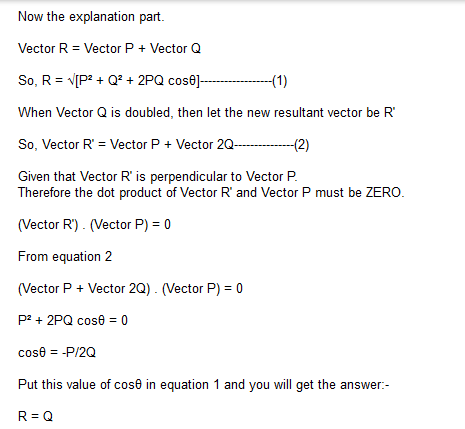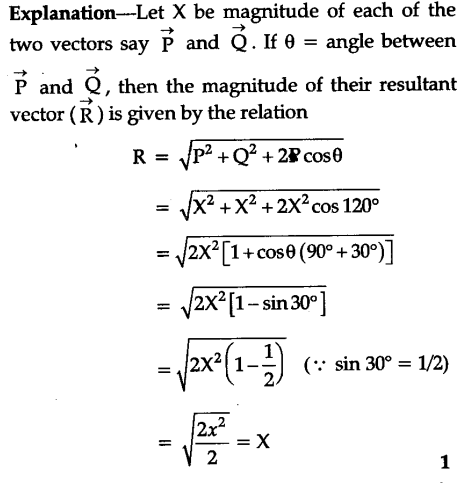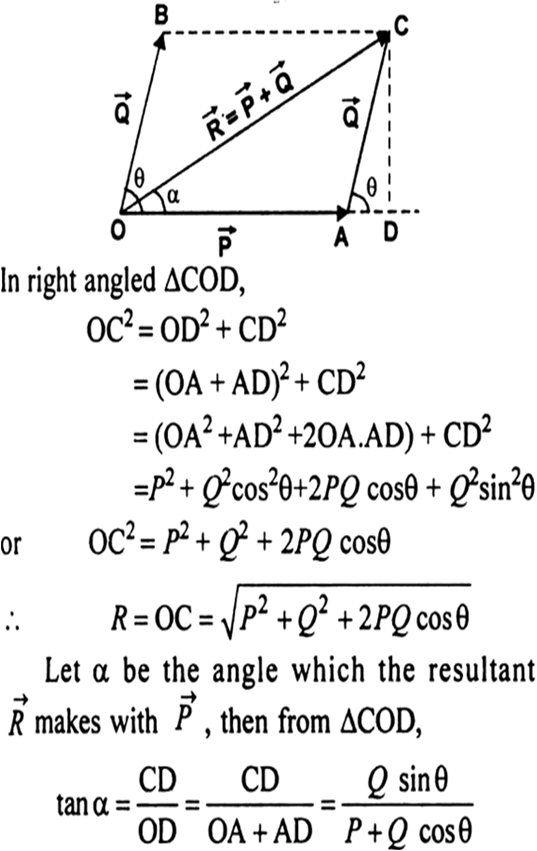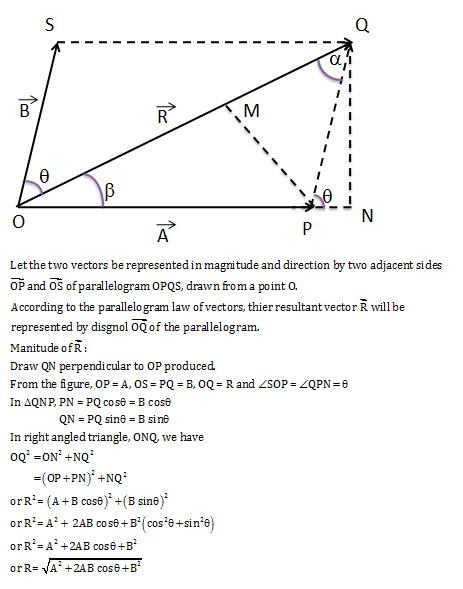Resultant Of Two Vectors Prove
The proof for the resultant vector in Parallelogram addition is as follows Consider a parallelogram OABC as shown in the figure. The resultant of two vectors of equal magnitude is equal to the magnitude of either of the two vectors.
When Does The Resultant Of Two Vectors Attain Its Maximum And Minimum Values Quora
The resultant is the vector sum of two or more vectors.
Resultant of two vectors prove. What happens to the resultant When two vectors that go in the same direction are added together. That is the maximum. If two vectors acting simultaneously at a point can be represented both in magnitude and direction by the adjacent sides of a parallelogram drawn from a point then the resultant vector is represented both in magnitude and direction by the diagonal of the parallelogram passing through that point.
Or Related Videos. Suppose two vectors a and b are having an angle eqtheta eq between them. Questions based upon parallelogram law of forces Q 1 Two forces 5 N and 20 N are acting at an angle of 120 degree between them.
To add or subtract two or more vectors we simply add each of the corresp. The two vectors are inclined to each other at 120. Methods for calculating a Resultant Vector.
The resultant of two vectors will be equal to either of them if. The vector vecc is calculated by adding our two vectors so. Explain under what conditions the resultant of two vectors will be equal to either of them.
Vectors can be added subtracted and multiplied. The resultant is the result of combining the individual vectors together. The two vectors are of the same magnitude.
If two vectors are represented in direction and magnitude by two adjacent sides of parallelogram then the resultant vector is given in magnitude and direction by the diagonal of the parallelogram starting from the common point of the adjacent sides. The head to tail method to calculate a resultant which involves lining up the head of the one vector with the tail of the other. EqR sqrta2 b2 2ab cos theta eq.
If 9 angle between P and Q then the magnitude of their resultant vector. Learn how to addsubtract vectors. In mathematics the resultant of two polynomials is a polynomial expression of their coefficients which is equal to zero if and only if the polynomials have a common root or equivalently a common factor.
The resultant is widely used in number theory either directly or through the discriminant which is essentially the resultant of a polynomial and its derivative. The resultant vector R 4139 msec downward to the right at x 7270. 012 Resultant of two velocity vectors.
The resultant vector is the vector that results from adding two or more vectors together. It is the result of adding two or more vectors together. Its because you are calculating the lengths of two different vectors.
The parallelogram method to calculate resultant vector. It should be noted that while finding the resultant vector of two vectors by the parallelogram law of vector addition the two vector A and B should be either act towards the point or away from the point. Then according to parallelogram law of vector addition diagonal OB represents the.
Let P and Q be two vectors acting simultaneously at a point and represented both in magnitude and direction by two adjacent sides OA and OD of a parallelogram OABD as shown in figure. There are a two different ways to calculate the resultant vector. Let be the angle between P and Q and R be the resultant vector.
R 4139 msec okay x 7270 downward to the right ok R 4139 msec ok x 7270 okay. Let vecRbe the resultant of vectors vecP and vecQ. The resultant can be determined by adding the individual forces together using vector addition methods.
The resultant of two. To say that vector R is the resultant displacement of displacement vectors A. Triangle Law of Vector Addition Derivation.
If displacement vectors A B and C are added together the result will be vector R. Follow answered Dec 16 15 at 807. In some older texts the resultant is also called the eliminant.
John Rennie John Rennie. And thats why you have two different equations. From triangle OCB OB2OC2BC2.
Vecc -veca vecb This is different from the vector we get if we add veca and vecb. Find the resultant vector of vectors A and B shown in Fig. There resultant is found as follows.
If resultant of two vectors of equal magnitude is equal to the magnitude of either vector then what is the angle between these vectors. When the two vectors point in exactly opposite directions the length of the resultant is the abs of the difference o. The resultant force is equal to.
Let x be the magnitude of each of the two vectors say P and Q. If two vectors are considered to be the adjacent sides of a parallelogram then the resultant of the two vectors is given by the vector that is diagonal passing through the point of contact of two vectors. When the two vectors point in the same direction the length of the resultant is the sum if the two lengths.
As shown in the diagram vector R can be determined by the use of an accurately drawn scaled vector addition diagram. Consider two vectors vecP and vecQ that are represented in the order of magnitude and direction by the sides OA and AB respectively of the triangle OAB. In summary the resultant is the vector sum of all the individual vectors.
If two vectors are considered to be the adjacent sides of a Parallelogram then the resultant of two vectors is given by the vector which is a diagonal passing through the point of contact of two vectors. Procedure Explanation Consider two vectors which are to be added as shown. What is the angle between the two vectors.

Find The Magnitude And Direction Of The Resultant Of Two Vectors A And B In The Terms Of Their M Youtube

Two Vectors Having Equal Magnitudes A Make An Angle Theta With Each Other Find The Magnitud Youtube

Resultant Of Two Vectors Of Magnitude P And Q Is Of Magnitude Q If The Magnitude Of Vecq Is Doubled Now The Angle Made By New Resultant With Vecp Is
The Result Of Two Vectors A And B Is Perpendicular To Vector A And Its Magnitude Is Equal To Half Of The Magnitude Of Vector B The Angle Between Vector A And

Two Vectors Having Equal Magnitudes A Make An Angle Theta With Eahc Other Find The Magnitude Youtube

Two Vector Both Are Equal In Magnitude Have Their Resultant Equal In Magnitude Of The Either Find The Angle Between The Two Vector

How To Show That The Resultant Of Two Equal Vectors Bisects The Angle Between The Vectors Quora

Q7 When The Angle Between Two Vectors Of Equal Magnitudes Is 2 3 Prove That The Magnitude Of The Resultant Is Equal To Either Physics Topperlearning Com Xizfn6oo
The Result Of Two Vectors A And B Is Perpendicular To Vector A And Its Magnitude Is Equal To Half Of The Magnitude Of Vector B The Angle Between Vector A And

Two Forces 3n And 4n Are Acting Perpendicular To Each Other What Is The Magnitude Of The Resultant Force And How Quora

Vector Application Find Magnitude And Angle Of The Resultant Force Youtube

How To Find The Resultant Of Two Vectors Youtube

The Resultant Of Two Vectors P And Q Is R If Q Is Doubled The New R Askiitians

The Resultant Of Two Vectors Vec A And Vec B Is Perpendicular To The Vector Youtube

Explain Under What Condition The Resultant Of Two Vector Will Be Equal To Either Of Them Studyrankersonline

Lesson 1 Vector Addition Numerical

Find The Magnitude And Direction Of The Resultant Of Two Vectors A And B In Terms Of Their Magnitudes Brainly In

Find The Magnitude And Direction Of Resultant Of Two Vectors Analytically Discuss The Special Cases For Angle Between The Vectors I 0 Ii 180 Iii 90 From Physics Motion In A Plane Class 11 Cbse

Discuss Parallelogram Law Of Vector Additionfind The Expression For Resultant Vector Using It Physics Topperlearning Com Ftvg944
Posting Komentar untuk "Resultant Of Two Vectors Prove"